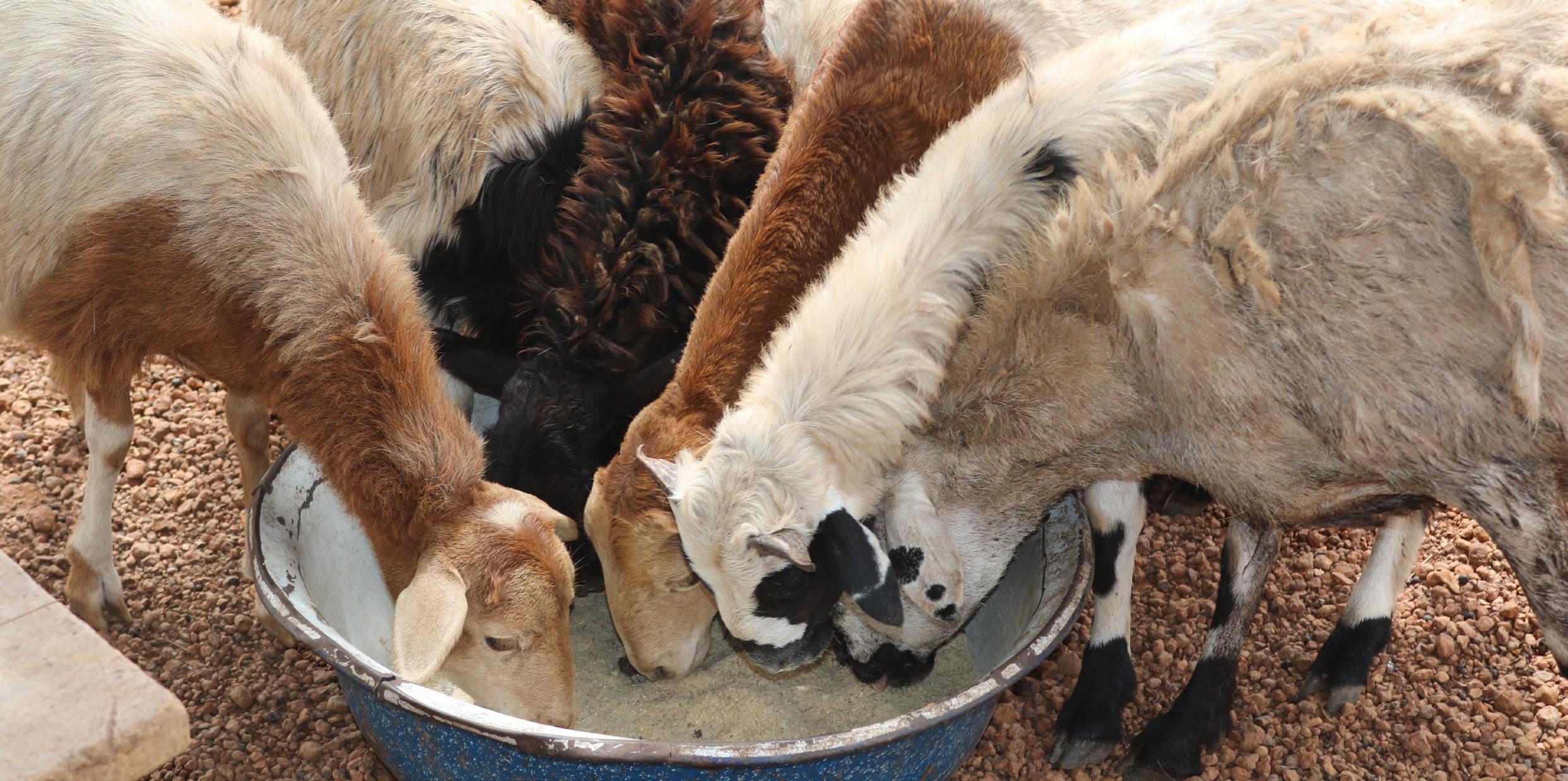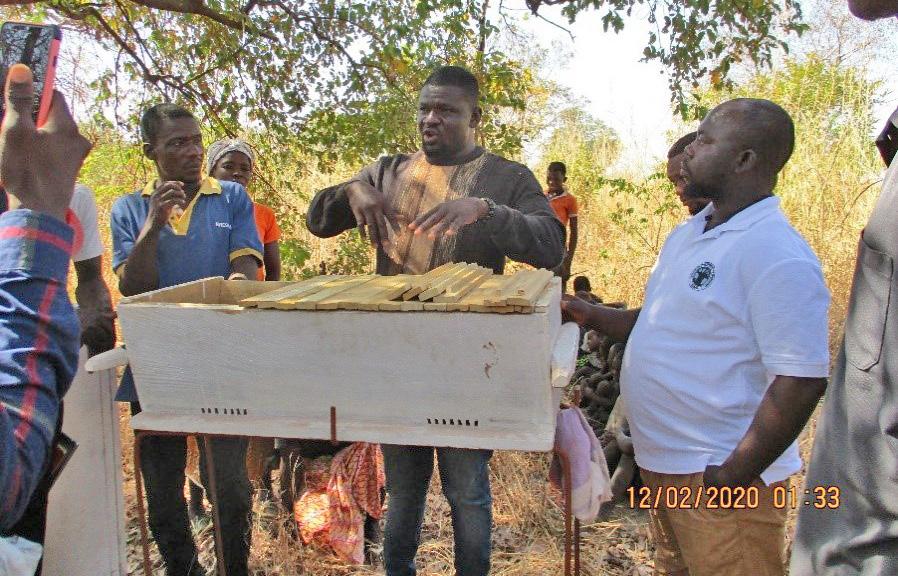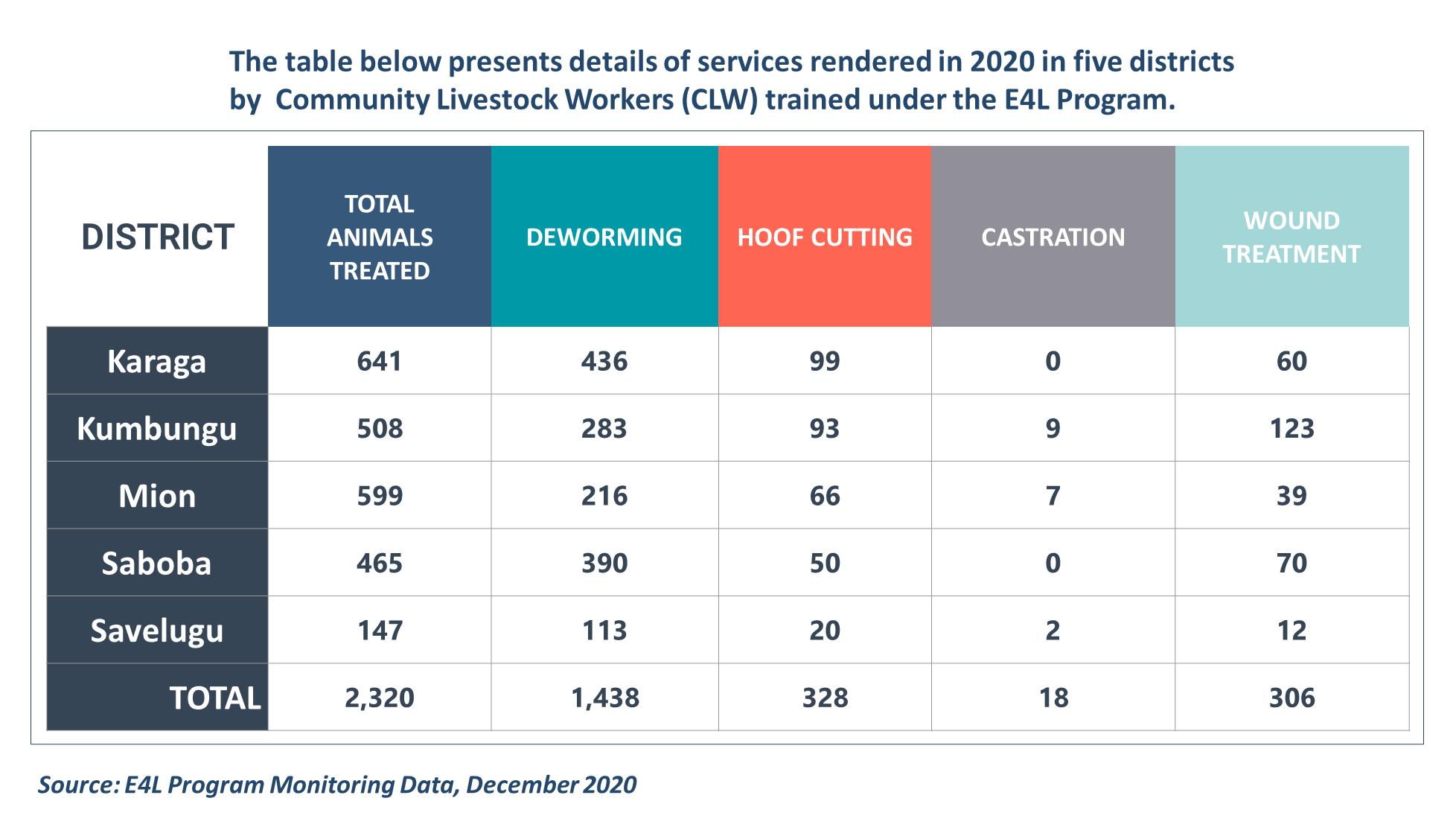
11 minute read
ENSURING INCLUSIVE GROWTH AND EMPLOYMENT
ENSURING INCLUSIVE GROWTH AND EMPLOYMENT
This section of the report presents the outcomes of the E4L program in line with four indicators: (i) Communities have adopted climate resilient livelihood strategies; (ii) Farmers use strategies and technologies to improve and diversify their livelihoods; (iii) Farmer groups have improved growth opportunities to make their businesses profitable and competitive and (iv) Women and youth start up and sustain their own businesses.
Advertisement
Girls and young women have better education opportunities
Vulnerability assessment conducted for communities in the five target districts, resilience technologies were explored and two of the technologies demonstrated in two districts (Saboba and Karaga). The target for 2020 was to demonstrate two technologies in three districts. However, the third demonstration could not happen because assessment showed that the Mion district was not adequately prepared for the demonstration.
The vulnerability assessment showed that local livelihoods are heavily dependent on rain-fed agricultural production and crop yields are decreasing due to shifting rainfall patterns and increasing temperatures. The program has successfully carried out two (2) demonstrations on the recommended appropriate resilient strategies in Saboba and Karaga districts on bee-keeping and irrigation respectively. That is, bee-keeping with three (3) beehives was demonstrated in Nayili community in the Saboba district. The technical capacities of the farmers were enhanced on how to effectively and efficiently manage bees to get maximum result. The farmers are therefore monitoring the beehives closely so as to address any challenges when they arise. As at December 2020 the bees were yet to enter into the beehives. The Zerizeri farmers in the Karaga District were supported to demonstrate irrigation for dry-season vegetable farming through pumping water from a perennial dam. The farmers have gained increased capacity from these demonstrations and are just beginning the farming process.

In 2020 the Farming-systems approach was developed and demonstrated in five districts. As a result of this demonstration 80 farmers from 10 farmer associations have diversified livelihoods through goat rearing in the communities. Thirty (30) farmer associations demonstrated new skills in organic compost preparation in their communities by preparing organic compost for their farms which increased their crop yield. Also, 50 youth Community Livestock Workers (CLW) are providing basic veterinary services to livestock owners in their communities. Through the 2020 Farmer Field Schools, farmers in the five districts are sharing knowledge in good agricultural practices with their colleagues by explaining to them how to do planting in rows, use of improved seeds, spacing and application of fertilizer. Furthermore, 42 farmer associations demonstrated improved capacity on the farming system approach by identifying and integrating the various components of their respective farming systems.
Through the assessment the farmer associations in all the districts recommended/ selected crop farming and livestock production as the best farming systems approach for them. As such 10 farmer associations (2 in each district) in the 5 districts were supported with goats to effectively integrate with their crop farming to reduce the risk of rain-fed crop farming and to provide alternative income for their households. Goat was chosen due to its easy multiplication, lower cost and easy to manage as compared to sheep. Monitoring visits disclosed that the farmers are using crops residues from their farms to feed the animals. The animals are kept in communal pens and this facilitates cross learning and adaptation among farmers in the communities especially during field days. Other benefits of rearing the goats in a communal pen include; short time visibility of results (reproduction) and maintenance of breed type. Each farmer association had a demonstration pen with seven (7) nannies and a billy to cross them giving a total ten (10) demonstrations and 80 goats. Thus, 80 farmers have diversified livelihoods through goat rearing in the communities. Preliminary evidence shows that Farmer groups in other communities have adopted the farming system approach to effectively integrate animal rearing with their crop farming. A good example is the Zieng Youth in development in the Nanton Area council which has integrated animal production with crop farming in the case story below.
Data available show that 50 Community Livestock Workers (CLW) are providing basic veterinary services to livestock owners in the five target districts. CLW are implementing action plans and as such have treated 2,320 animals across the 5 districts. They are using income from their activities to support their businesses and farming activities. For instance, Mr. Salifu S. Yussif from Nangunkpang has increased his farm from 2 acres in 2019 to 4 acres in 2020 due to income realized from his activities as CLW. This increase in acreage has increased his yield from 10bags of soya beans in 2019 to 20 bags in 2020. The activities of the CLWs have reduced the incidence of animal mortality and morbidity in the communities. The health conditions of the animals have improved and are attracting better market prices.
Zieng Youth in development integrates animal production with crop farming
In 2019, after receiving training in animal management the group bought five sheep to rear as a start up to go into animal rearing. This year, the group wants to expand what was started last years and therefore cultivated 4 acres of rice and 2 acres of groundnut. This they say will help them to raise funds to support the group activities and to expand their animals rearing business.
In the last quarter, the Zieng youth in development acquired three additional sheep with each sheep costing an amount of four hundred Ghana cedis (GHC 400.00). This is done in line with their plans to generate income to improving food security and livelihood in their homes and the community.
The skills acquired by the CLWs have inspired some of them to further their education to become official veterinary officers. For instance, Alhassan Ayuba a CLW in Pishigu community in the Karaga District, gained admission to study animal health science in College of Agriculture in Damongo.

Thirty (30) farmer associations prepared and applied their own organic compost and hence recorded increase in crop yields. After receiving capacity building on organic compost preparation from E4L program, these farmers mobilised the necessary materials and prepared their own organic compost in their farms. This was discovered during the second phase of organic compost preparation- turning of the organic compost in the E4L districts. These farmers recorded increased crop yields after applying the organic compost in their farms. For instance, Gmaljon Taagan, Ullen Thomas and Uyan James in Gnalaajodo community in the Saboba district prepared and applied organic compost in their farms which resulted in increased crop yield. These are specific examples of individuals who recorded increased yields. The table below presents highlights of the increased yield. Similar examples of increased crop yield due to the application of organic fertilizers by farmers has been recorded in Savelugu, Mion, Karaga and Kumbungu districts. This year two varieties of maize – sanzal sima (yellow maize) and Obaatampa were demonstrated in each of the five districts. Each variety was done on an acre of land making 2 acres per demonstration in each district. Through the Farmer Field Schools, farmers in the five districts are sharing knowledge in good agricultural practices by explaining to their colleagues in the communities how to do planting in rows, use of improved seeds, spacing and application of fertilizer during farmer field days. The demonstration farms in Saboba, Karaga, Mion and Kumbungu recorded an average of 7 bags per acre.
Examples of individuals with increased yield
Name of
Farmer Yield Before Organic Compost
Yield After Organic Compost
Gmaljon Taagan 10 bags 7 bags Ullen Thomas 6 bags 10 bags Uyan James 4 bags 10 bags
Source: E4L Program Monitoring Data, 2020

Source: E4L Program Monitoring Data, 2020
That is, Saboba had 10 bags, Mion recorded 6 bags, Kumbungu recorded 12 bags, and Karaga district also recorded 6 bags. The farm in Savelugu recorded 4 bags per acre due to the poor nature of the farmland. The demonstration was done on a farmland that could not have been used by any farmer in the community for maize farming due to poor fertility. During a community durbar to present the results of the demonstration farms to the community members, the farmers were surprise the demonstration farm could produce that result. Similarly, community durbars were organized in the remaining 4 districts to explain the demonstration process and present the results to the wider community members and other actors.
The Tungteiya shea butter processing enterprise has improved the quality of their business and as such attracted new wholesale and retail customers who buy between 5 – 15 tonnes of shea butter per month. They also have developed improved packaging for customers who are buying in kilos/ smaller units. Similarly, Zegbansuma, suhudoo rice and Tisongtaaba rice all reported to have increased customers and hence they recorded improved sales and profit than before. All the six businesses indicated they had increased customers’ base in 2020. All the businesses indicated they are recording increased profits due to the enhanced capacity from the incubator program. The kinyandal soap group has recorded increased profit from GHC 14,400 in 2019 to GHC 28,900 in 2020. Similarly, the Tisongtaaba rice in Mion District has also recorded increased profit from GHC 1,200 in 2019 to GHC 1,500 in 2020. The businesses have also improved on keeping records of their financial/business transactions. The six business cases all keep and manage bank accounts.
The businesses have improved on keeping records of their financial/business transactions. The Kinyandal soap making group, Zegbansuma farmers and suhudoo rice have hired people in the communities to keep records of their business transactions. Similarly, the Tungteiya shea butter enterprise has records for sales and purchases of shea butter and nuts.
The business groups have demonstrated improved capacity in the development and implementation of their marketing action plans. The 6 business cases after receiving training on marketing action plans have developed and are implementing their marketing action plans. The farmer business groups demonstrate improved capacity in marketing and promoting their businesses to make profits and become more competitive. The Kinyandal soap making group has identified new markets (clients) in Saboba market, Wapuli market, and the SHS in Saboba town. Before participating in the business incubator model, they were only concentrating in small markets/community
such as the Kujooli market and surrounding communities. Furthermore, the group has advertised their products (soap) on radio Gaaki and this has attracted new customers from Yenkazia community among others. GAWU has change its name to Zegbansuma and this has attracted more customers for them. Tungteiya shea butter enterprise through body shop (key customer) has supported them to acquire an acre of land in Mbanayili community to plant shea nut seedlings. In all, 1400 shea nut seedlings have been planted to promote the production of nuts in the community.
The six business cases all keep and manage bank accounts. The Tungteiya shea butter enterprise keep two accounts, Ghana Commercial bank (GCB) and absa bank (formerly Barclays). The Kinyandal soap group has an account with GCB, Suhudoo rice and Zerizeri farmers with Bonzali rural bank and Zegbansuma with Borimanga rural bank. Also, the businesses have improved on savings for reinvestment in to the business. That is, the Village Savings and Loans Association for the businesses has become more effective due to increase income from the businesses.
Women and youth start up and sustain their own businesses
Monitoring show that 89 youth entrepreneurs trained in the last quarter of 2019 representing 71.2% have established and running their businesses. Also, 36 others are being supported to also start their businesses. However about 15 out of the 36 are at different stages of learning a vocation.
For the year 2020 a total of 202 youth was trained on entrepreneurship in 2020. Out of this number, 89 non-literate young women were trained under the young women in literacy initiative. Out of the 113-youth trained under the usual mixed bootcamp 39 were females and 74 were males. The Mion district training for non-literate young women was suspended because of challenges and poor preparation of the group in Mion. The group in Mion were trained in the first week of February 2021 and 23 non-literate young women participated in the training. Overall, it means that out of the overall 202 young people trained there are 128 young women and 74 young men. Number of youths trained per district for the general entrepreneurship bootcamp training are presented in Figure 7. In 2020, Saboba district recorded more females than males (14 females and only 8 males). This is the first time that more females have participated in the general entrepreneurship trainings.
For the non-literate young women 98 were supported to learn literacy and numeracy through E4L facilitated classes and this enabled them to participate in the entrepreneurship boot camp trainings. In total 89 gained entrepreneurial skills through the entrepreneurship boot camp trainings.
Figure 7: Number of youths trained on mixed gender entrepreneurship per district in 2020








